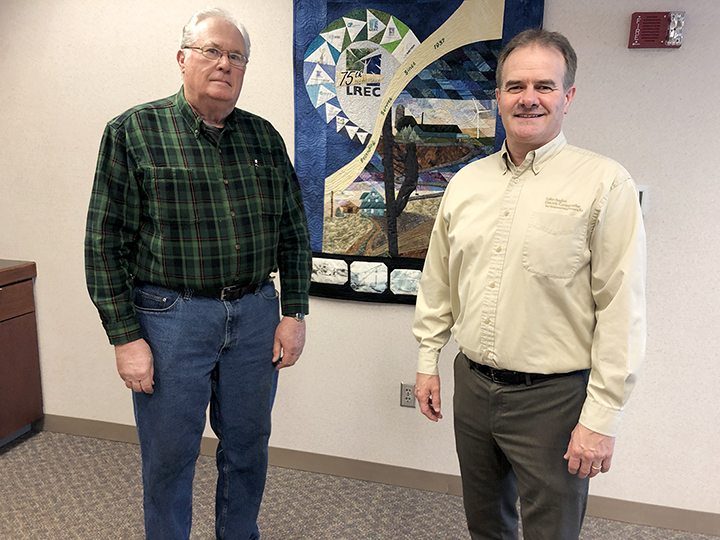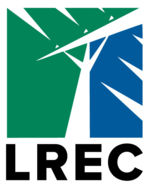From natural gas to solar-wind, Pelican headquartered electric co-op capitalizes on diversification
By Louis Hoglund for Pelican Rapids Press and used with permission.
Billed as essentially the first “community” solar-wind project of its kind in the nation, the solar array and wind turbine installation has generated positive cash-flow for Lake Region Electric Cooperative—in just two years of operation.
The project had a difficult start. Lake Region initially proposed the project at sites in Scambler and Dunn Townships in the Pelican Lake area, but hit staunch opposition from lake area property owners—plus potential conflicts over the proximity to the Pelican city airport.
But a location in the less-developed area of Trondhjem Township, southwest of Pelican Rapids, came together with hardly a whimper of opposition. In its first ten months of operation, the installation generated $200,000 in clean energy.
 Lake Region Electric Cooperative officials took their “show on the road” earlier this winter, delivering an update to nearly 250 members from the region.
Lake Region Electric Cooperative officials took their “show on the road” earlier this winter, delivering an update to nearly 250 members from the region.
By all accounts, the customers responded with favorable reviews with the performance of the member-owned electric utility.
The takeaway from the cooperative’s district meetings, held throughout the service area, is fairly simple:
- Rates, costs to customers—stable.
- “Margins,” basically revenues over and above operating costs–up
- Consumer satisfaction–on the rise.
But the story behind those three basic points is much more involved, interesting and—enlightening.
“Alternative energy,” in large part, can be pointed to as a major component in the cooperative’s continued success: Natural gas, solar and wind.
Membership totals about 25,000, across four counties; with Pelican Rapids at approximately the center and headquarters for the Lake Region system.
Natural gas business already generating margin
And those members will be pleased to know that Lake Region’s diversification into the natural gas business has been a key factor in the cooperative’s rate stabilization strategy.
“We pondered entering the natural gas business for a couple years,” said outgoing, 15-year board member Charles Kvare, Pelican Lake area. Board members placed a condition before committing to natural gas: “It had to be profitable by the end of the second year of operation,” said Kvare.
Profitable it was—and ahead of projections.
The initiative was launched in the Deer Creek-Parkers Prairie areas, with nearly 650 natural gas connections now on line.
“That area was totally unserved,” said the co-op’s chief executive Tim Thompson, Pelican Rapids. In addition to a solid concentration of potential residential customers, LREC identified a number of larger volume users. Among them, the Parkers Prairie school district and a number of larger turkey growing operations, which demand a high volume of energy.
“It’s an improvement of the quality of life, saving energy costs for the school and as much as $300 to $500 a year for households,” said Thompson of the Parkers Prairie area natural gas initiative.
Taking even some of the cooperative’s officials by surprise—the natural gas operation earned net profits of nearly $82,000 in the second full year of business. Lake Region’s bottom line experienced an even heftier secondary benefit. Because a number of staff are now cross-trained for both electric and gas utility work, the gas operation in effect, spread $184,000 of existing operating costs to the gas company.
Natural gas expansion set for Little McDonald area
The combined impact is $265,000, by adding the gas company,” said Thompson. Further, he noted, a completely new business was added—with no net increase in the number of employees. As an example of the efficiencies in cross-training and assigning workers to both electric and gas operations, it was noted that Pelican native Brady Roisum is one of several of the Lake Region team that is fully trained and qualified to work in both operations.
From an accounting standpoint, the gas company is technically not a “cooperative,” but is operated as a separate subsidiary of Lake Region Electric.
So successful was the cooperative’s diversification into gas, that 2020 expansions include the Miltona area, and the Little McDonald lake area, east of Vergas.
Rural Pelican wind-solar project new energy source
Natural gas isn’t the only energy innovation in recent years.
Lake Region has invested in solar power, including its “solar garden” located at the Lake Region headquarters, just south of Pelican Rapids city.
An innovative wind turbine and solar panel installation southwest of Pelican, has generated nearly $200,000 in clean energy in its first ten months of operation.
Believed to be the first project of its kind in the nation, the solar-wind combo was a tough sell initially—as the large turbine installation hit stiff opposition at two earlier proposed sites in the Pelican Lake area.
But a less developed rural area, in Trondhjem Township, was ultimately selected. The big advantage to this project is that there was no risk, no investment on the part of Lake Region and its members. Juhl Energy and General Electric completed the project, said Thompson. “All we’re being billed for is the energy it produces,” said Thompson. And, that energy generated also ties into the co-op’s rate stabilization objectives—keeping costs down to Lake Region customers.
Referred to as a “community wind-solar” installation, the Trondhjem project is viewed as a “pilot” for similar installations elsewhere in the nation.
Sub-station improvements total $21.2 million over two years
Energy delivery improvements will benefit more than 18,000 customers—or about 75 percent of the members.
Substation improvements totalling $21.2 million—including the Lake Eunice station, as well as Frazee, Schuster Lake and Henning on the eastern side of the Lake Region service area.
The substation upgrades improve reliability. Much of the substation investment was undertaken by Great River Energy, which is a power-supplier to Lake Region and other utilities—which means the improvements were at no direct cost to Lake Region members.
______________________________________________________________
Lake Region officials tout stable rates, high satisfaction
District meetings were well attended, as Lake Region Electric Cooperative officials delivered the news of 2019 for the Pelican Rapids-headquartered utility.
The meeting held in the heart of the lake country was hosted by St. Mary’s of the Lakes, attracting 80 consumers. Meetings in Frazee and Battle Lake drew a combined 160.
Among the highlights of 2019, shared by chief executive Tim Thompson:
- Lake Region’s rates are the second lowest among 14 similar Minnesota electric co-ops.
- Reliability is a key issue for the average resident, business or farm customer. The average hour of outages in 2004 was 4.4 hours. In 2019, that was down to 1.4 hours. These exclude major blizzards or summer storms.
- “Capital credits,” which is essentially a return on investment to Lake Region members, totalled $1.67 million—the highest ever, noted Pelican Lake area board member Charles Kvare. Since 1958, credits returned to members totalled $28.5 million. This is the seventh straight year Lake Region member have received more than $1 million annually.
- Total equity, which in general is a barometer of Lake Region’s financial health, was $58 million in 2019. This is up from $23 million in 2005. “The proof is in our financial strength, from then to now,” said Kvare.
- Based on customer surveys, the satisfaction went from 8.6 to 8.9 over the past year.
- Lake Region’s “Round Up” program has donated $304,000 to area charities and non-profits, ranging from the Pelican food shelf to the Dunvilla shooting range to scholarship funds —which serves youth from Pelican Rapids and other area and schools and organizations.
- A successful revenue source for the Lake Region co-op is the “standby generator program,” launched in 2017. Nearly 200 of the generators are pulling in $344,000, delivering an operating margin of $83,213 to the cooperative.
 Lake Region Electric Cooperative
Lake Region Electric Cooperative